Subscribe to our ▶️ YouTube channel 🔴 for the latest videos, updates, and tips.
Division of a Decimal by a Whole Number
We will learn how to find the quotient in division of a decimal by a whole number.
To divide a decimal number by a whole number the division is performed in the same way as in the whole numbers. We first divide the two numbers ignoring the decimal point and then place the decimal point in the quotient in the same position as in the dividend.
The rules to divide a decimal by a whole number are:
(i) Divide as in division of numbers ignoring the decimal point.
(ii) When you reach the tenths digit, place the decimal in the quotient.
Note:
When the number of digits in the dividend is less and the division is
not complete, keep adding zeroes at every step till the division is
complete as in example 1 and example 2.
1. Solve: 100.4 ÷ 25
100.4 ÷ 25
Therefore, 100.4 ÷ 25 = 4.016
2. Find 1.2 ÷ 25
1.2 ÷ 25
= (12/10) ÷ 25
= (12/10) ×(1/25)
= (12 × 1)/(10 × 25)
= 12/250
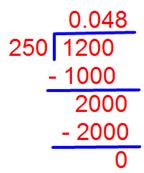
Alternative Method:
Therefore, 1.2 ÷ 25 = 0.048
3. Divide 115.8 by 6
Hence, 115.8 ÷ 6 = 19.3
4. Divide 335.8 by 23
Hence, 335.8 ÷ 23 = 14.6
5. Divide: 191.5 ÷ 5
191.5 ÷ 5
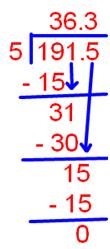
Therefore, 191.5 ÷ 5 = 36.3
This example shows that both dividend and quotient have decimal place i.e. 1.
6. Divide: 1.21 ÷ 11
First we will divide the decimal by the whole number ignoring decimal point.
Now put the decimal point in the quotient in such a way, that the decimal place in the quotient becomes equal to the decimal places in the dividend.
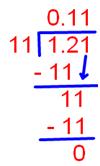
Therefore, 1.21 ÷ 11 = 0.11 (dividend has 2 decimal places, therefore
quotient also has 2 decimal places)
7. Divide: 798.3 ÷ 36
798.3 ÷ 36
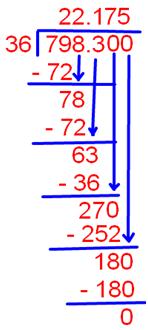
Therefore, 798.3 ÷ 36 = 22.175
8. Divide: 0.007 ÷ 14
0.007 ÷ 14
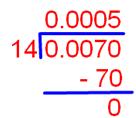
Therefore, 0.007 ÷ 14 = 0.0005 (dividend has 4 decimal places, therefore quotient also has 4 decimal places)
9. Divide: 24.66 ÷ 12
24.66 ÷ 12
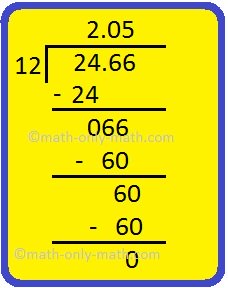
Therefore, 24.66 ÷ 12 = 2.05 (dividend has 2 decimal places, therefore quotient also has 2 decimal places)
10. Divide: 316.84 ÷ 8
316.84 ÷ 8
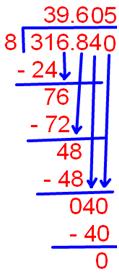
Therefore, 316.84 ÷ 8 = 39.605
11. Divide: 6.30 ÷ 7
6.30 ÷ 7

Therefore, 6.30 ÷ 7 = 0.90
(dividend has 2 decimal places, therefore
quotient also has 2 decimal places)
12. Divide: 1020.102 ÷ 51
1020.102 ÷ 51
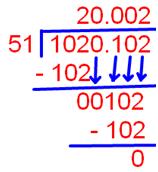
Therefore, 1020.102 ÷ 51 = 20.002 (dividend has 3 decimal places, therefore quotient also has 3 decimal places)
● Decimal.
- Tenth Place in Decimals
- Hundredths Place in Decimals
- Thousandths Place in Decimals
- Whole Numbers and Decimals
- Decimal Place Value Chart.
- Expanded form of Decimal Fractions
- Like Decimal Fractions.
- Unlike Decimal Fraction.
- Equivalent Decimal Fractions.
- Changing Unlike to Like Decimal Fractions.
- Ordering Decimals
- Comparison of Decimal Fractions.
- Conversion of a Decimal Fraction into a Fractional Number.
- Conversion of Fractions to Decimals Numbers.
- Addition of Decimal Fractions.
- Problems on Addition of Decimal Fractions
- Subtraction of Decimal Fractions.
- Problems on Subtraction of Decimal Fractions
- Multiplication of a Decimal Numbers.
- Multiplication of a Decimal by 10, 100, 1000
- Multiplication of a Decimal by a Decimal.
- Properties of Multiplication of Decimal Numbers.
- Problems on Multiplication of Decimal Fractions
- Division of a Decimal by a Whole Number.
- Division of Decimal Fractions
- Division of Decimal Fractions by Multiples.
- Division of a Decimal by a Decimal.
- Division of a whole number by a Decimal.
- Properties of Division of Decimal Numbers
- Problems on Division of Decimal Fractions
- Conversion of fraction to Decimal Fraction.
- Simplification in Decimals.
- Word Problems on Decimal.
5th Grade Math Problems
From Division of a Decimal by a whole number to HOME PAGE
Didn't find what you were looking for? Or want to know more information about Math Only Math. Use this Google Search to find what you need.
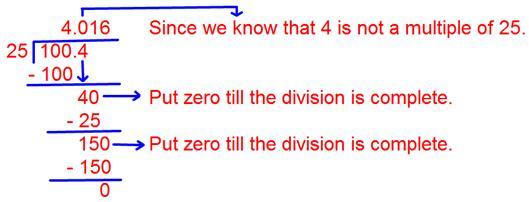
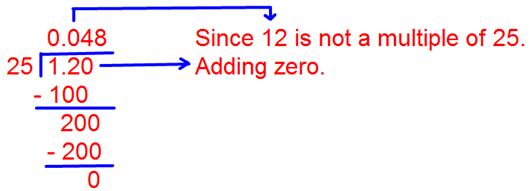
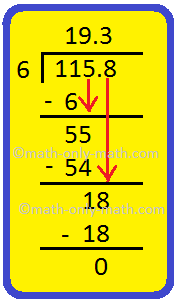
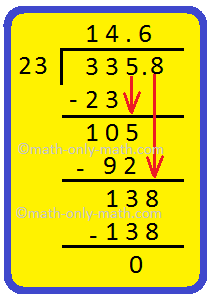
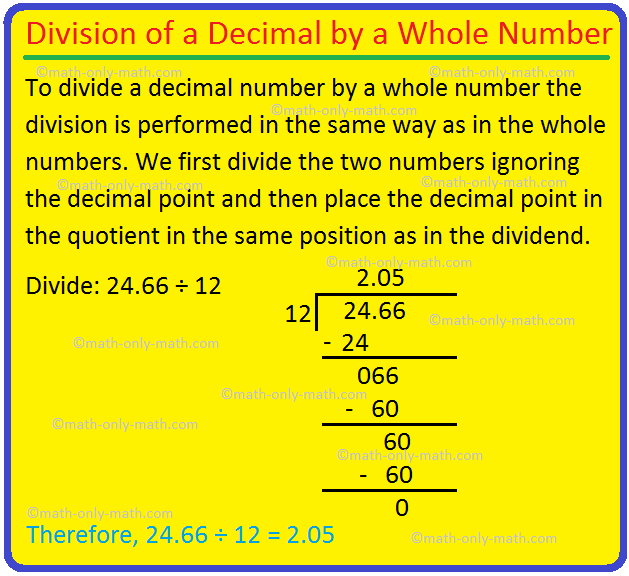


New! Comments
Have your say about what you just read! Leave me a comment in the box below. Ask a Question or Answer a Question.